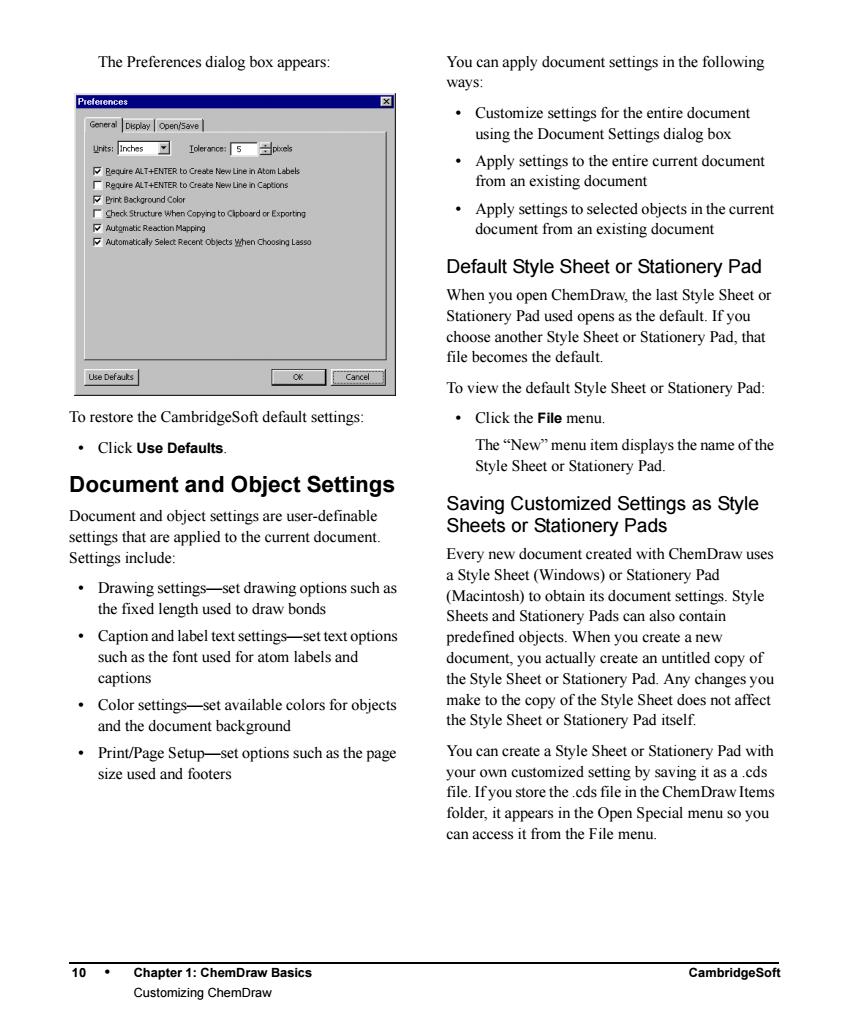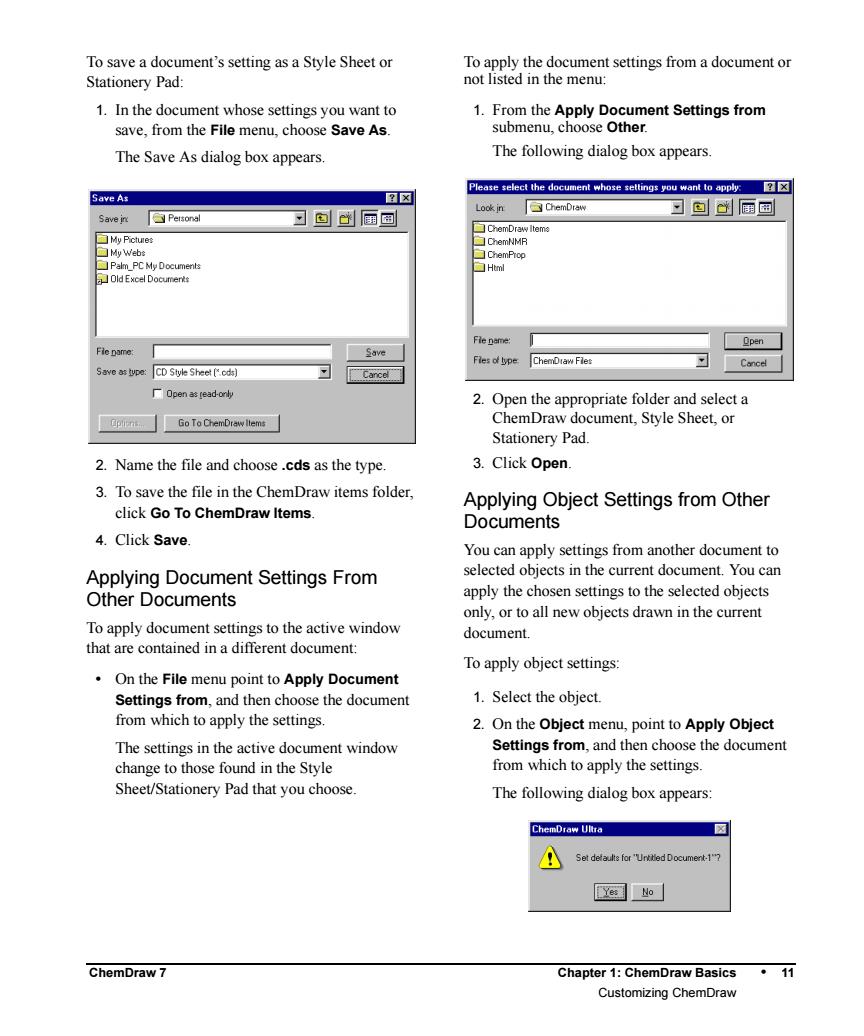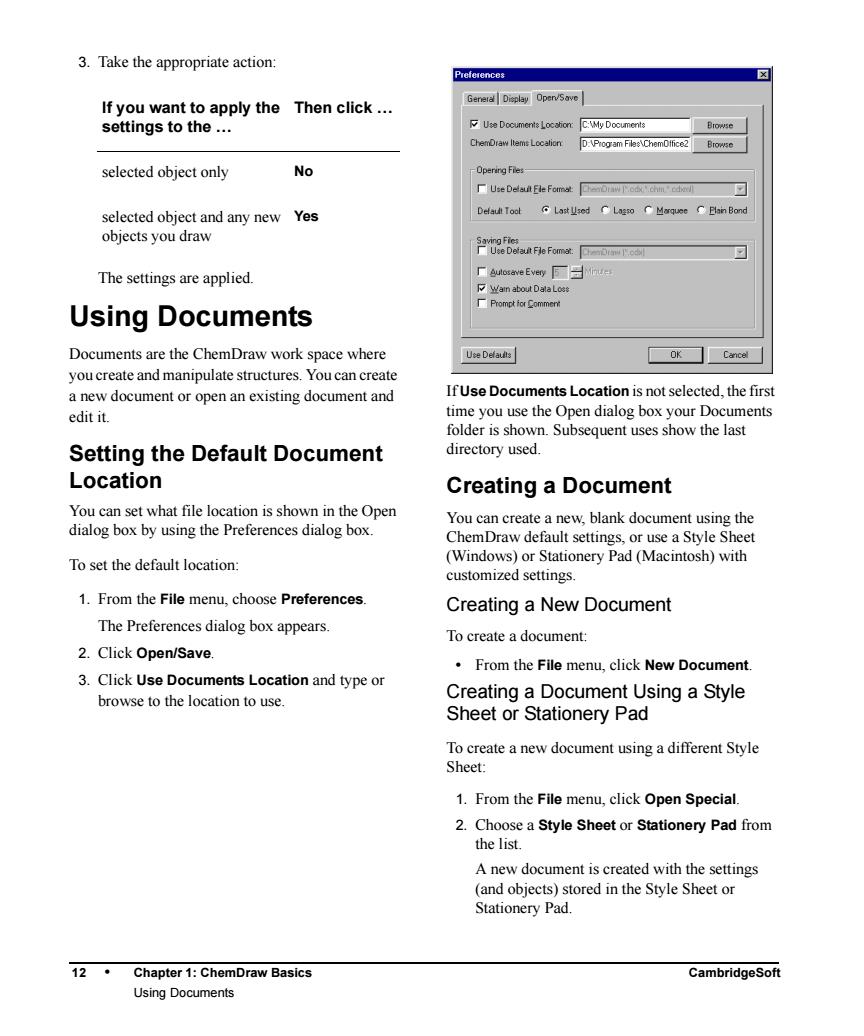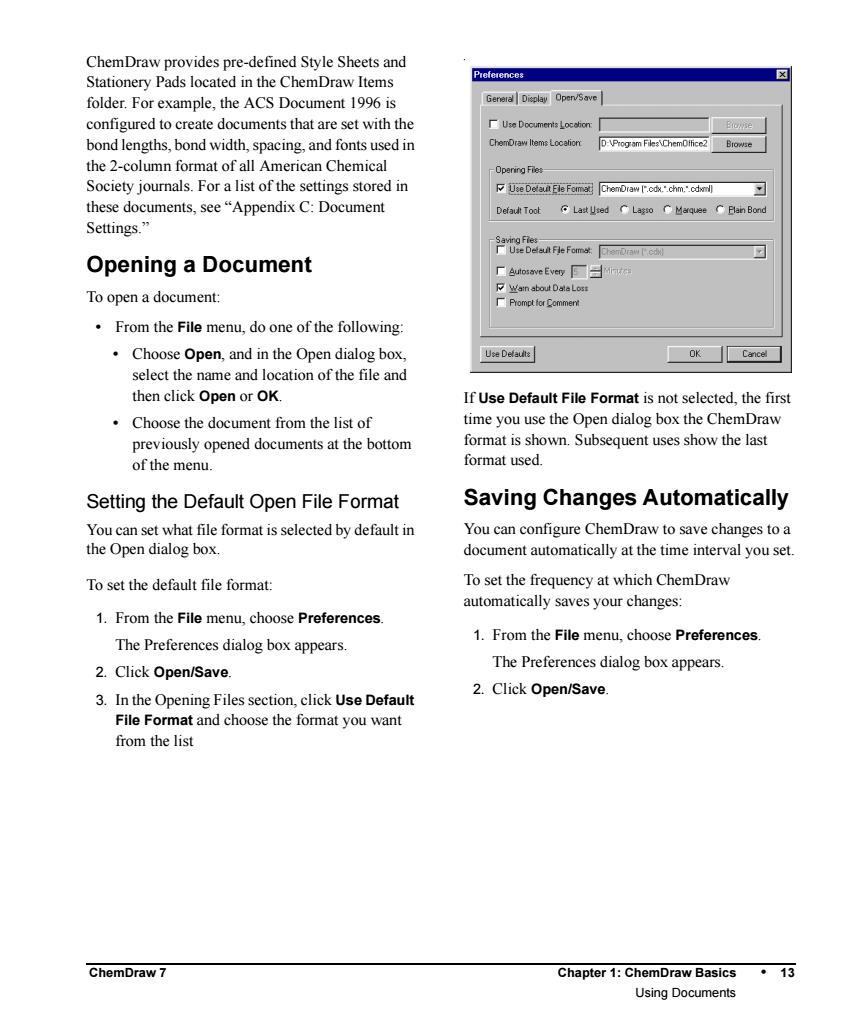
The Preferences dialog box appears You can apply document settings in the following ways: .Customize settings for the entire documen using the Document Settings dialog box Apply settings to the entire current document from an existing document Apply settings to selected objects in the current document from an existing document Default Style Sheet or Stationery Pad When you open ChemDraw,the last Style Sheet or Stationery Pad used opens as the default.If you choose another Style Sheet or Stationery Pad,that file becomes the default. Uhe Defauts To view the default Style Sheet or Stationery Pad To restore the CambridgeSoft default settings: ·Click the File menu. ·Click Use Defaults The"New"menu item displays the name of the Style Sheet or Stationery Pad. Document and Object Settings Document and obiect settings are user-definable Saving Customized Settings as Style settings that are applied to the current document Sheets or Stationery Pads Settings include: Every new document created with ChemDraw uses -set drawing options such as a Style Sheet(Windows)or Stationery Pad ·Drawing settings (Macintosh)to obtain its document settings.Style the fixed length used to draw bonds Sheets and Stationery Pads can also contain Caption and label text settings-set text options predefined objects.When you create a new such as the font used for atom labels and document,you actually create an untitled copy of captions the Style Sheet or Stationery Pad.Any changesyou .Color settings-set available colors for objects make to the copy of the Style Sheet does not affect and the document background the Stvle Sheet or Stationery Pad itself. Print/Page Setup-set options such as the page You can create a Style Sheet or Stationery Pad with size used and footers your own customized setting by saving it as a.cds file.If you store the.cds file in the ChemDraw Items folder,it appears in the Open Special menu so you can access it from the File menu. 10 Chapter1:ChemDraw Basics Customizing ChemDraw
10 • Chapter 1: ChemDraw Basics CambridgeSoft Customizing ChemDraw Administrator The Preferences dialog box appears: To restore the CambridgeSoft default settings: • Click Use Defaults. Document and Object Settings Document and object settings are user-definable settings that are applied to the current document. Settings include: • Drawing settings—set drawing options such as the fixed length used to draw bonds • Caption and label text settings—set text options such as the font used for atom labels and captions • Color settings—set available colors for objects and the document background • Print/Page Setup—set options such as the page size used and footers You can apply document settings in the following ways: • Customize settings for the entire document using the Document Settings dialog box • Apply settings to the entire current document from an existing document • Apply settings to selected objects in the current document from an existing document Default Style Sheet or Stationery Pad When you open ChemDraw, the last Style Sheet or Stationery Pad used opens as the default. If you choose another Style Sheet or Stationery Pad, that file becomes the default. To view the default Style Sheet or Stationery Pad: • Click the File menu. The “New” menu item displays the name of the Style Sheet or Stationery Pad. Saving Customized Settings as Style Sheets or Stationery Pads Every new document created with ChemDraw uses a Style Sheet (Windows) or Stationery Pad (Macintosh) to obtain its document settings. Style Sheets and Stationery Pads can also contain predefined objects. When you create a new document, you actually create an untitled copy of the Style Sheet or Stationery Pad. Any changes you make to the copy of the Style Sheet does not affect the Style Sheet or Stationery Pad itself. You can create a Style Sheet or Stationery Pad with your own customized setting by saving it as a .cds file. If you store the .cds file in the ChemDraw Items folder, it appears in the Open Special menu so you can access it from the File menu. Windows Preferences

To save a document's setting as a Style Sheet or To apply the document settings from a document or Stationery Pad: not listed in the menu: 1.In the document whose settings you want to save,from the File menu,choose Save As. 1Bmehtapep8eoentsotngstonm ose Other. The Save As dialog box appears. The following dialog box appears. Please telect the document whote settingt wou want to apply Save As x 卫回属回 My Pi P ie pame Save Save as type:CD Stvle Sheet ['cds) 2.Open the appropriate folder and select a ChemDraw document,Style Sheet,or Stationery Pad. 2.Name the file and choose.cds as the type. 3.Click Open. 3.To save the file in the ChemDraw items folder, Applying Object Settings from Other click Go To ChemDraw Items. Documents 4.Click Save. You can apply settings from another document to Applying Document Settings From selected objects in the current document.You can Other Documents apply the chosen settings to the selected objects only,or to all new objects drawn in the current To apply document settings to the active window document. that are contained in a different document: To apply object settings: On the File menu point to Apply Document Settings from,and then choose the document 1.Select the object. from which to apply the settings 2.On the Object menu,point to Apply Object The settings in the active document window Settings from,and then choose the document change to those found in the Style from which to apply the settings. Sheet/Stationery Pad that you choose The following dialog box appears Ch A Set defaults for'Untded Do 的 ChemDraw 7 Chapter 1:ChemDraw Basics 11 Customizing ChemDraw
ChemDraw 7 Chapter 1: ChemDraw Basics • 11 Customizing ChemDraw To save a document’s setting as a Style Sheet or Stationery Pad: 1. In the document whose settings you want to save, from the File menu, choose Save As. The Save As dialog box appears. 2. Name the file and choose .cds as the type. 3. To save the file in the ChemDraw items folder, click Go To ChemDraw Items. 4. Click Save. Applying Document Settings From Other Documents To apply document settings to the active window that are contained in a different document: • On the File menu point to Apply Document Settings from, and then choose the document from which to apply the settings. The settings in the active document window change to those found in the Style Sheet/Stationery Pad that you choose. To apply the document settings from a document or not listed in the menu: 1. From the Apply Document Settings from submenu, choose Other. The following dialog box appears. 2. Open the appropriate folder and select a ChemDraw document, Style Sheet, or Stationery Pad. 3. Click Open. Applying Object Settings from Other Documents You can apply settings from another document to selected objects in the current document. You can apply the chosen settings to the selected objects only, or to all new objects drawn in the current document. To apply object settings: 1. Select the object. 2. On the Object menu, point to Apply Object Settings from, and then choose the document from which to apply the settings. The following dialog box appears:

3.Take the appropriate action If you want to apply the Then click... settings to the... D:\Piogram Filee\ChemOifice2 Browse selected object only No selected object and any new Yes objects you draw The settings are applied. Using Documents Documents are the ChemDraw work space where you create and manipulate structures.You can create a new document or open an existing document and IfUse Documents Location is not selected.the first edit it. time you use the Open dialog box vour Documents folder is shown.Subsequent uses show the last Setting the Default Document directory used Location Creating a Document You can set what fil n is shown in the Open di box by using the Preferences dialog box ChemDraw default settings To set the default location: customized settings. 1.From the File menu,choose Preferences Creating a New Document The Preferences dialog box appears To create a document 2.Click Open/Save. From the File menu,click New Document. 3.Click Use Documents Location and type or browse to the location to use. Creating a Document Using a Style Sheet or Stationery Pad To create a new document using a different Style Sheet 1.From the File menu,click Open Special. 2.Choose a Style Sheet or Stationery Pad from the list. A new document is created with the settings (and objects)stored in the Style Sheet or 12 Chapter 1:ChemDraw Basics CambridgeSof Using Documents
12 • Chapter 1: ChemDraw Basics CambridgeSoft Using Documents Administrator 3. Take the appropriate action: The settings are applied. Using Documents Documents are the ChemDraw work space where you create and manipulate structures. You can create a new document or open an existing document and edit it. Setting the Default Document Location You can set what file location is shown in the Open dialog box by using the Preferences dialog box. To set the default location: 1. From the File menu, choose Preferences. The Preferences dialog box appears. 2. Click Open/Save. 3. Click Use Documents Location and type or browse to the location to use. If Use Documents Location is not selected, the first time you use the Open dialog box your Documents folder is shown. Subsequent uses show the last directory used. Creating a Document You can create a new, blank document using the ChemDraw default settings, or use a Style Sheet (Windows) or Stationery Pad (Macintosh) with customized settings. Creating a New Document To create a document: • From the File menu, click New Document. Creating a Document Using a Style Sheet or Stationery Pad To create a new document using a different Style Sheet: 1. From the File menu, click Open Special. 2. Choose a Style Sheet or Stationery Pad from the list. A new document is created with the settings (and objects) stored in the Style Sheet or Stationery Pad. If you want to apply the settings to the … Then click … selected object only No selected object and any new objects you draw Yes

ChemDraw provides pre-defined Style Sheets and Stationery Pads located in the ChemDraw Items folder.For example,the ACS Document1996 is configured to create documents that are set with the Use Doc bond lengths,bond width,spacing,and fonts used in the 2-column format of all American Chemical re Society journals.For a list of the settings stored in Use Fie Fom ChonDraw P'.od.'.chm." these documents,see"Appendix C:Document Defaut Took Settings." Uge Delat Fle Fom Opening a Document To open a document From the File menu,do one of the following: Choose Open,and in the Open dialog box, Uge Delaulte OK Cancel☐ select the name and location of the file and then click Open or OK. If Use Default File Format is not selected the first Choose the document from the list of time you use the Open dialog box the ChemDraw previously opened documents at the bottom format is shown.Subsequent uses show the last of the menu. format used Setting the Default Open File Format Saving Changes Automatically You can set what file format is selected by default in You can configure ChemDraw to save changes to a the Open dialog box. document automatically at the time interval you set To set the default file format To set the frequency at which ChemDraw automatically saves your changes: 1.From the File menu,choose Preferences. The Preferences dialog box appears. 1.From the File menu,choose Preferences. 2.Click Open/Save. The Preferences dialog box appears. 3.In the Opening Files section,click Use Default 2.Click Open/Save. File Format and choose the format you want from the list ChemDraw 7 Chapter 1:ChemDraw Basics 13 Using Documents
ChemDraw 7 Chapter 1: ChemDraw Basics • 13 Using Documents ChemDraw provides pre-defined Style Sheets and Stationery Pads located in the ChemDraw Items folder. For example, the ACS Document 1996 is configured to create documents that are set with the bond lengths, bond width, spacing, and fonts used in the 2-column format of all American Chemical Society journals. For a list of the settings stored in these documents, see “Appendix C: Document Settings.” Opening a Document To open a document: • From the File menu, do one of the following: • Choose Open, and in the Open dialog box, select the name and location of the file and then click Open or OK. • Choose the document from the list of previously opened documents at the bottom of the menu. Setting the Default Open File Format You can set what file format is selected by default in the Open dialog box. To set the default file format: 1. From the File menu, choose Preferences. The Preferences dialog box appears. 2. Click Open/Save. 3. In the Opening Files section, click Use Default File Format and choose the format you want from the list . If Use Default File Format is not selected, the first time you use the Open dialog box the ChemDraw format is shown. Subsequent uses show the last format used. Saving Changes Automatically You can configure ChemDraw to save changes to a document automatically at the time interval you set. To set the frequency at which ChemDraw automatically saves your changes: 1. From the File menu, choose Preferences. The Preferences dialog box appears. 2. Click Open/Save

3.Click Autosave Every and type or select the For example,if you draw cyclohexane,create an minutes to use. atom label text box,type a label,and select and rotate the structure,you will be able to remove the actions as follows: General Diplay Open/Save 1.Remove the rotation 厂UwDa 2.Remove atom label 3.Remove the ring. At each step,the text of the Undo command Delault Tool Last Used C Lagto C Morquee C Elain Bon indicates the action being removed. Redoing Actions When you undo an action,the Redo command becomes active so you can reverse the effect of the Undo command. ok☐cnew To redo the last action undone From the Edit menu,choose Redo. The time starts counting down after the first change The last action undone is reinstated.The Undo is made. mand changes s to reflect that action.The Reversing and Repeating Redo command changes to reflect the next action that can be redone Actions ChemDraw keeps track of the actions you perform Repeating Actions You can reverse actions one at a time by choosing If an action is repeatable,the name of the action the Undo command.The number of actions that can appears next to the Repeat command on the Edit be undone or redone is limited only by the amount Menu. of memory(RAMand virtual memory)available for To repeat an action: use by ChemDraw.When you save your document the Undo queue is reset and starts over. From the Edit menu,choose Repeat. The last action performed is repeated. Undoing Actions To undo the last action performed: From the Edit menu,choose Undo. The last action performed is reversed.The Redo command changes to reflect the undone action. The Undo command changes to reflect the next action you can undo. 14 Chapter1:ChemDraw Basics CambridgeSof Using Documents
14 • Chapter 1: ChemDraw Basics CambridgeSoft Using Documents Administrator 3. Click Autosave Every and type or select the minutes to use. The time starts counting down after the first change is made. Reversing and Repeating Actions ChemDraw keeps track of the actions you perform. You can reverse actions one at a time by choosing the Undo command. The number of actions that can be undone or redone is limited only by the amount of memory (RAM and virtual memory) available for use by ChemDraw. When you save your document the Undo queue is reset and starts over. Undoing Actions To undo the last action performed: • From the Edit menu, choose Undo. The last action performed is reversed. The Redo command changes to reflect the undone action. The Undo command changes to reflect the next action you can undo. For example, if you draw cyclohexane, create an atom label text box, type a label, and select and rotate the structure, you will be able to remove the actions as follows: 1. Remove the rotation. 2. Remove atom label. 3. Remove the ring. At each step, the text of the Undo command indicates the action being removed. Redoing Actions When you undo an action, the Redo command becomes active so you can reverse the effect of the Undo command. To redo the last action undone: • From the Edit menu, choose Redo. The last action undone is reinstated. The Undo command changes to reflect that action. The Redo command changes to reflect the next action that can be redone. Repeating Actions If an action is repeatable, the name of the action appears next to the Repeat command on the Edit Menu. To repeat an action: • From the Edit menu, choose Repeat. The last action performed is repeated